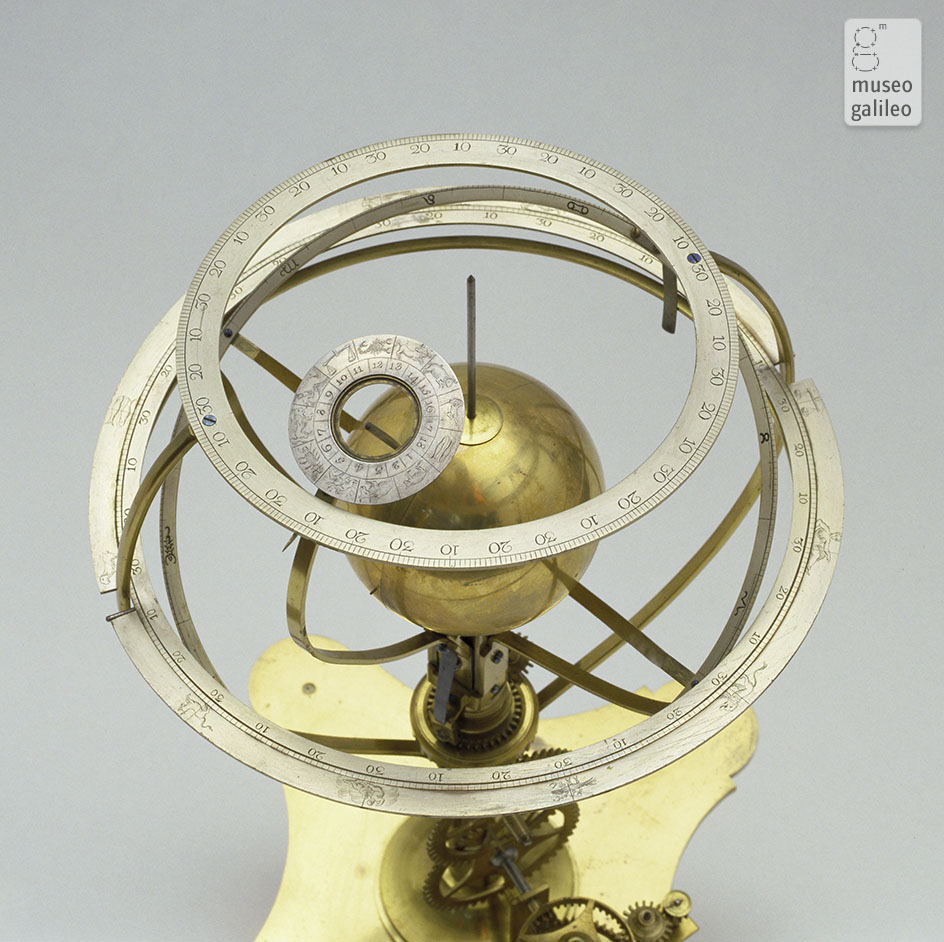
World History 173: The Age of Revolution
- Scientific Revolution
- The Enlightenment
- Industrial Revolution
- American Revolution
- French Revolution
- Haitian Revolution
Artifacts

Illustration of the Copernican system of the universe from Galileo's "Dialogue Concerning the Two Chief World Systems, Ptolemaic & Copernican", 1632
In 1624, Galileo travels to Rome, where he has audiences with Pope Urban VIII and several cardinals. The Pope grants Galileo permission to address Copernican theory in his writing on the condition that he only lend it the weight of a hypothesis. Galileo finishes his work in April for Dialogue Concerning Two Chief World Systems, which includes his treatise on the tides. It is published two years later (1632).
.Click here for more information about Galileo and his difficulties with the Roman Catholic Church.

Model for the demonstration of precession of the equinoxes and nutation (Inv. 1465)
For more on the model, click Here
Model for explaining the very slow motion called precession of the equinoxes. The phenomenon—which sparked scientific and doctrinal controversies—was investigated for several centuries. It was one of the arguments cited by Copernicus in support of his astronomical system. The model, actuated by a series of hand-operated gears, also simulates the nutation of the Earth's axis.

Optical toy by Ludovico Buti, 1593
For more information on the object, click Here
If we view the board from the top toward the lower front, the row of visible sides of the painted sticks displays the portrait of Charles III, Duke of Lorraine; if, using the mirror placed in front, we observe the arrangement from the opposite side, we see the portrait of the Grand Duchess Christina of Lorraine, daughter of Charles III and wife of Ferdinand I de' Medici.

Engraving from the book: Tycho Brahe (1598), Astronomiae instauratae mechanica, Wandsbeck.
From Wikimedia Commons: The observer (right) views a star through the opposite opening (upper left) to determine the star's altitude as it passes through the meridian. An assistant (lower right) reads the time off a clock and another one (lower left) records the measurements. The area above the quadrant is filled with a mural painting showing several other of Brahe's instruments.
Deeper Dives
Deeper Dives
Science, Space and Human Discovery (41:00)
-
On Garlic, Magnets and The Scientific RevolutionFor over 1,500 years, scholars believed in a fact that any child could disprove with a simple test. Two approaches developed in the 16th century changed the situation
Scientific Revolution
**Items marked with a key icon  require your GBS ID (number only) and password for home access**
require your GBS ID (number only) and password for home access**
Items marked with  are primary sources. Items marked with
are primary sources. Items marked with  are scholarly resources.
are scholarly resources.
Background/Overviews
Setting the Stage
Key Figures & Their Work
-
Whose Revolution? Copernicus, Brahe & Kepler
 Essay and links to primary source materials
Essay and links to primary source materials -
Galileo and the Telescope
 Essay and links to primary source materials
Essay and links to primary source materials -
René Descartes
 Focuses on his contributions to mathematics, as opposed to philosophy.
Focuses on his contributions to mathematics, as opposed to philosophy.
Influence & Legacy
Why science must embrace imagination, intuition, and evidence (4:10)
- Last Updated: Oct 28, 2025 9:31 AM
- URL: https://gbslibguides.glenbrook225.org/whrevolutions
- Print Page
4000 West Lake Avenue Glenview, Illinois 60026 | Email:GBS LibGuides Administrator | Reference Desk: 847 486 4574